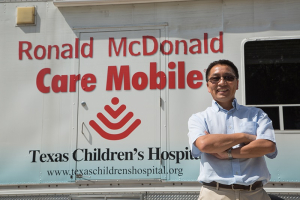The National Science Foundation isn’t asking too much – just present potentially transformative research that might improve people’s lives and they might be eager to give you money through their Early-concept Grant for Exploratory Research (EAGER) program.
As luck would have it, Jiming Peng, UH Cullen College associate professor of industrial engineering, has such a plan. It’s called “Increasing Healthcare Access to At-Risk-Populations in Smart Communities: Optimal Deployment of Mobile Health Clinics,” a joint project with colleagues from the UT School of Public Health in Houston. The idea is to expand mobile clinics in underserved areas, which could definitely change lives for the better in Houston, where mobile clinics figure prominently in delivering health care to at-risk populations. In Houston about 30 mobile clinics currently offer care ranging from routine and cancer screenings to dental work for over one-million people.
Seeing the value and need, the NSF awarded Peng $125,000 for two years of research beginning in September. But if this was a ballgame, Peng’s research would already be on third base. In January, 2016, the Texas Medical Center awarded Peng and his colleagues a budget of $150,000 for a pilot project to improve the lives of Texans by coming up with research-based policies for mobile health clinics.
“I’m an optimization guy.”
Peng’s expertise as an optimization expert, maximizing the revenue or minimizing the loss under certain operational and budgetary constraints, makes him a perfect fit for this project. Peng is pouring over demographic data to optimize and deploy mobile health clinics to better serve the needs of Houstonians.
He’s already discovered that one problem with mobile clinics in Houston is the lack of coordination in scheduling. Preliminary study in the pilot project shows him there’s a better way.
“Every major hospital has a mobile clinic, but there’s not enough coordination among them,” said Peng. “Sometimes they have to travel too far. For example, every time the UTMB mobile clinic, located in Galveston, is scheduled to [visit] the very north part of Houston, it has to travel two-to-three hours.”
That’s lost time that could be spent treating patients. The next task is to make sure the mobile clinics are servicing the correct areas.
“Some of Houston’s service spots are not carefully selected,” said Peng. He said sometimes that’s based on the relationships of certain neighborhoods and hospitals, and he believes his research will help change that.
“Once we identify the needs in the greater Houston area we can assign and coordinate between the program providers and the local communities,” he said.
Altogether, Peng says his plan to strategically re-route and locate the clinics will allow them to serve 20-30 percent more people while keeping the cost exactly the same.
Stage Two
For the NSF grant, Peng will try to predict what the future healthcare demands will be in Houston. He will develop optimization models and resolution techniques that use geographic information systems (GIS), demographic and economic population data to identify systematic, technology-based deployment of mobile health clinics as well as optimal strategies to expand the mobile clinic service to meet the future demand. That kind of future-casting puts the “smart” in smart communities from the research title.
“Based on our research we can predict the demand for this kind of service in the future,” said Peng.
It looks like Houston is going to need it. According to Peng, moderate estimates in a recent study indicate the population in the metropolitan Houston area will be over 8 million in 2030 and over 10 million by 2050.
That’s a lot of health care needed, but with Peng on the job, the solutions will no doubt be optimized.
